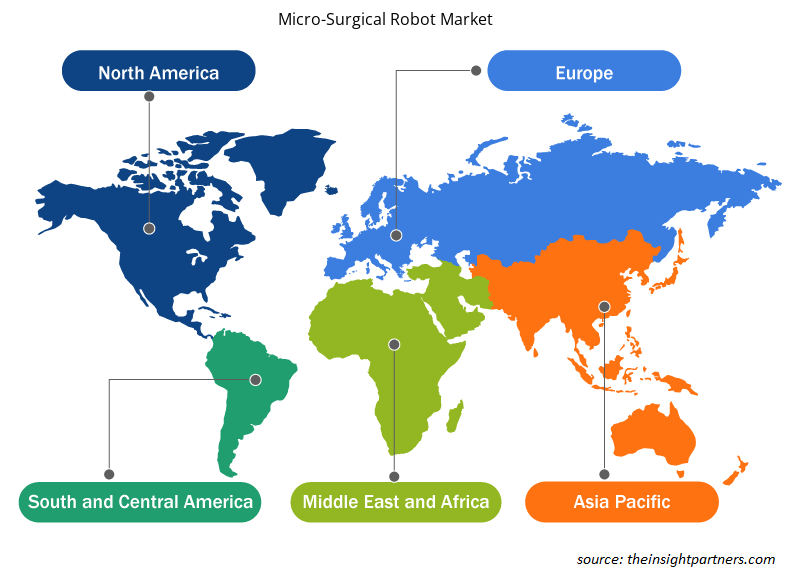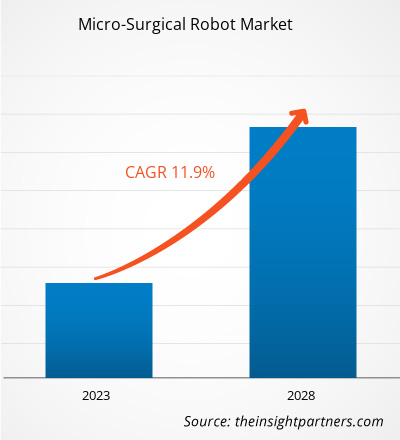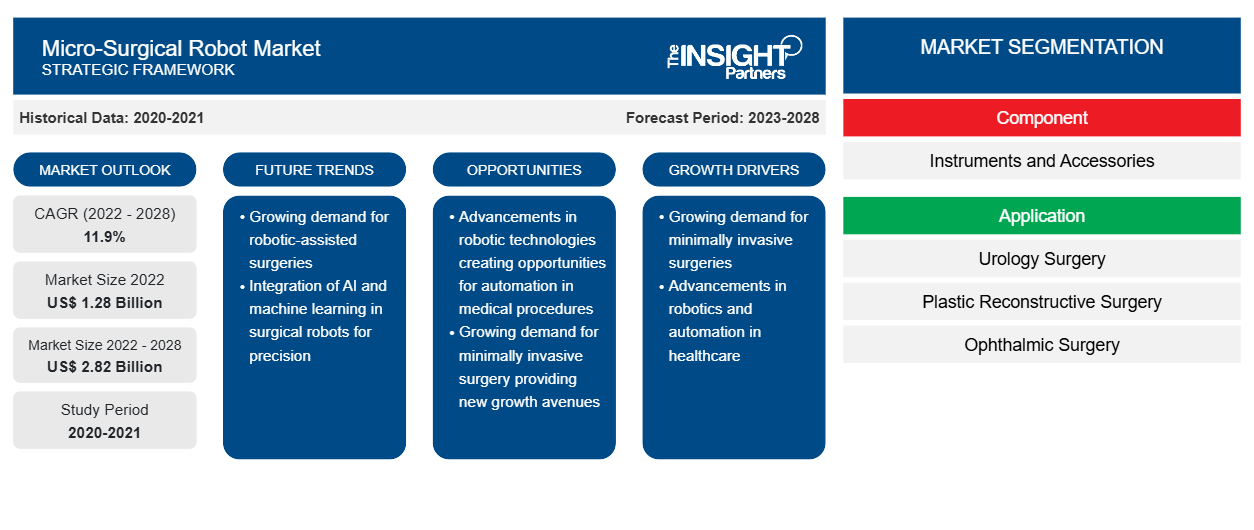Se espera que el mercado de robots microquirúrgicos crezca de US$ 1.280,81 millones en 2022 a US$ 2.817,57 millones en 2028; se espera que crezca con una CAGR del 11,9% de 2022 a 2028.
Los robots microquirúrgicos se utilizan para realizar microcirugías , es decir , procedimientos quirúrgicos intracorporales y extracorporales . Los robots pueden ayudar a realizar procedimientos quirúrgicos complejos de forma más flexible y precisa, lo que es posible con las técnicas convencionales. Los robots microquirúrgicos realizan procedimientos quirúrgicos mínimamente invasivos con incisiones diminutas. Las ventajas de los robots microquirúrgicos son menos complicaciones, pequeñas cicatrices, menor pérdida de sangre y una recuperación más rápida. La creciente popularidad de los procedimientos quirúrgicos mínimamente invasivos y las ventajas de las cirugías robóticas en términos de precisión, repetibilidad, control y eficiencia impulsan el crecimiento del mercado mundial de robots microquirúrgicos . Sin embargo, el alto costo de los robots microquirúrgicos y los escenarios de reembolso desfavorables en diferentes países están obstaculizando el crecimiento del mercado.
El informe ofrece información y un análisis profundo del mercado mundial de robots microquirúrgicos, haciendo hincapié en parámetros como las tendencias del mercado, los avances tecnológicos, la dinámica del mercado y el análisis del panorama competitivo centrado en los principales actores del mercado. También incluye el impacto de la pandemia de COVID-19 en el mercado en todas las regiones. Muchas autoridades sanitarias recomendaron evitar el contacto humano debido a la creciente transmisión y la presión sobre los recursos sanitarios posponiendo las cirugías electivas, suspendiendo las clínicas ambulatorias y clasificando a los empleados involucrados en la atención de urgencias. Las cirugías robóticas utilizan inteligencia artificial (IA), que se beneficia a través de tres aspectos: aumentar la precisión y reducir el riesgo de falla al brindar autonomía compartida y completa en tareas simples; permitir el distanciamiento físico al cambiar el rol del cirujano de ejecutivo a supervisor y de personal de control continuo a personal de control intermitente; y aumentar el número promedio de procedimientos quirúrgicos, que serán necesarios para abordar las cirugías atrasadas causadas por el cierre de las cirugías electivas durante un largo período. Por lo tanto, el mercado mundial de robots microquirúrgicos experimentó un impacto positivo después de la primera ola de COVID-19.
Personalice este informe según sus necesidades
Obtendrá personalización en cualquier informe, sin cargo, incluidas partes de este informe o análisis a nivel de país, paquete de datos de Excel, así como también grandes ofertas y descuentos para empresas emergentes y universidades.
- Obtenga las principales tendencias clave del mercado de este informe.Esta muestra GRATUITA incluirá análisis de datos, desde tendencias del mercado hasta estimaciones y pronósticos.
El mercado mundial de robots microquirúrgicos está segmentado en función de los componentes, la aplicación, el usuario final y la geografía. Por geografía, el mercado está ampliamente segmentado en América del Norte, Europa, Asia Pacífico, Oriente Medio y África, y América del Sur y Central.
Perspectivas de mercado
Ventajas de las cirugías robóticas en términos de precisión, repetibilidad, control y eficiencia
La introducción de la cirugía robótica es el avance más reciente en la liposucción. Un cirujano controla los tratamientos desde una consola maestra, mientras que el carro robótico para el paciente realiza los procedimientos con mayor facilidad y precisión que los sistemas laparoscópicos. Debido a su visión y precisión en 3D y a sus instrumentos intuitivos de múltiples rangos, la cirugía robótica tiene claras ventajas en los procedimientos de liposucción en comparación con las cirugías laparoscópicas tradicionales, lo que garantiza una mayor seguridad para el paciente. Las cirugías robóticas también ayudan a mejorar las habilidades de sutura y a reducir el dolor posoperatorio y el tiempo de recuperación. La liposucción asistida por robot también se recomienda para personas obesas que pesen más de 250 kg, ya que la liposucción laparoscópica es más exigente y difícil. Según un artículo - “Comparación de los resultados quirúrgicos entre la cirugía robótica integrada y la laparoscópica convencional para la gastrectomía distal : un análisis de emparejamiento por puntaje de propensión”, publicado en 2020, la tasa de éxito quirúrgico en el grupo de gastrectomía distal robótica integrada ( IRDG ) fue del 98%, significativamente mayor que la tasa de éxito en el grupo de gastrectomía distal laparoscópica convencional ( CLDG ), es decir , 89,5%. Aunque ambos grupos tuvieron tasas similares de problemas hospitalarios y ambulatorios, la tasa de readmisión del grupo IRDG fue mucho menor que la del grupo CLDG . Además, las cirugías robóticas ayudan a mejorar las capacidades de visualización, proporcionando a los cirujanos una mejor vista del área de trabajo y permitiéndoles ver detalles microscópicos utilizando cámaras de alta definición. Estos sistemas tienen más destreza que la mano humana, y su capacidad para rotar 360° y navegar mejor permite a los cirujanos llegar a áreas de difícil acceso. Un equipo de investigadores ha combinado un brazo propulsado por nitrógeno (como un quinto brazo robótico) con un sistema de lentes de video de aumento óptico (brazo Point-Setter y lente VITOM de Karl Storz , Tuttlingen , Alemania) para desarrollar una plataforma robótica para tratamientos microquirúrgicos robóticos extracorpóreos . El VITOM es un sistema de video exoscópico de alta definición con lentes ópticas que se utilizan para cirugía de columna y cirugía pediátrica. El aumento óptico en el sistema varía de 16× a 25×. El microcirujano puede ver la imagen desde el sistema VITOM justo debajo de la vista principal de la cámara 3D del robot utilizando el software de imágenes TilePro en la interfaz del cirujano. De esta manera, las microcirugías robóticas Garantizar una mayor precisión, repetibilidad, control y eficiencia. En línea con el creciente deseo de servicios de atención médica mejores y más rápidos, estos beneficios de los robots microquirúrgicos impulsan el crecimiento del mercado.
Información basada en componentes
Según los componentes, el mercado mundial de robots microquirúrgicos se divide en instrumentos y accesorios. En 2022, se espera que el segmento de instrumentos tenga una mayor participación de mercado. Se estima que el mercado de este segmento crecerá a una tasa compuesta anual más rápida durante el período de pronóstico.
Perspectivas basadas en aplicaciones
Según la aplicación, el mercado de robots microquirúrgicos se segmenta en cirugía plástica reconstructiva, cirugía otorrinolaringológica , cirugía urológica, neurocirugía , cirugía oftálmica, cirugía linfática y otras. En 2022, se estima que el segmento de cirugía urológica representará la mayor participación del mercado. Se espera que el mismo segmento registre la CAGR más alta entre 2022 y 2028.
Información basada en el usuario final
Según el usuario final, el mercado de robots microquirúrgicos se segmenta en hospitales y clínicas, centros quirúrgicos ambulatorios, institutos de investigación y otros. En 2022, se espera que el segmento de hospitales y clínicas tenga la mayor participación del mercado. Se espera que el mismo segmento registre la CAGR más alta entre 2022 y 2028. El crecimiento del mercado de robots microquirúrgicos para el segmento de hospitales y clínicas se atribuye al aumento en el número de procedimientos quirúrgicos y la adopción de equipos avanzados en estas instalaciones.
Los actores del mercado de robots microquirúrgicos adoptan estrategias orgánicas, como el lanzamiento y la expansión de productos, para ampliar su presencia global y su cartera de productos y satisfacer la creciente demanda. Por ejemplo, en mayo de 2022, MMI SpA anunció el lanzamiento de su simulador de sistema quirúrgico Symani, desarrollado por VirtaMed.
Perspectivas basadas en la geografía
Por geografía, el mercado mundial de robots microquirúrgicos está segmentado en América del Norte, Europa, Asia Pacífico (APAC), Oriente Medio y África (MEA) y América del Sur y Central. El mercado de América del Norte está segmentado a su vez en Estados Unidos, Canadá y México. El mercado de robots microquirúrgicos en Europa está subsegmentado en Francia, Alemania, Reino Unido, España, Italia y el resto de Europa. El mercado de robots microquirúrgicos de APAC está subsegmentado en China, India, Japón, Australia, Corea del Sur y el resto de APAC. El mercado de MEA está segmentado a su vez en Arabia Saudita, Emiratos Árabes Unidos, Sudáfrica y el resto de MEA. El mercado de robots microquirúrgicos en América del Sur y Central está subsegmentado en Brasil, Argentina y el resto de SAM.
Perspectivas regionales del mercado de robots microquirúrgicos
Los analistas de Insight Partners explicaron en detalle las tendencias y los factores regionales que influyen en el mercado de robots microquirúrgicos durante el período de pronóstico. Esta sección también analiza los segmentos y la geografía del mercado de robots microquirúrgicos en América del Norte, Europa, Asia Pacífico, Oriente Medio y África, y América del Sur y Central.

- Obtenga datos regionales específicos para el mercado de robots microquirúrgicos
Alcance del informe de mercado de robots microquirúrgicos
| Atributo del informe | Detalles |
|---|---|
| Tamaño del mercado en 2022 | 1.280 millones de dólares estadounidenses |
| Tamaño del mercado en 2028 | US$ 2.82 mil millones |
| CAGR global (2022-2028) | 11,9% |
| Datos históricos | 2020-2021 |
| Período de pronóstico | 2023-2028 |
| Segmentos cubiertos | Por componente
|
| Regiones y países cubiertos | América del norte
|
| Líderes del mercado y perfiles de empresas clave |
|
Densidad de actores del mercado de robots microquirúrgicos: comprensión de su impacto en la dinámica empresarial
El mercado de robots microquirúrgicos está creciendo rápidamente, impulsado por la creciente demanda de los usuarios finales debido a factores como la evolución de las preferencias de los consumidores, los avances tecnológicos y una mayor conciencia de los beneficios del producto. A medida que aumenta la demanda, las empresas amplían sus ofertas, innovan para satisfacer las necesidades de los consumidores y aprovechan las tendencias emergentes, lo que impulsa aún más el crecimiento del mercado.
La densidad de actores del mercado se refiere a la distribución de las empresas o firmas que operan dentro de un mercado o industria en particular. Indica cuántos competidores (actores del mercado) están presentes en un espacio de mercado determinado en relación con su tamaño o valor total de mercado.
Las principales empresas que operan en el mercado de robots microquirúrgicos son:
- MMI SpA
- Microsure BV
- Corporación Stryker
- Cirugía intuitiva, Inc.
- Medtronic
Descargo de responsabilidad : Las empresas enumeradas anteriormente no están clasificadas en ningún orden particular.

- Obtenga una descripción general de los principales actores clave del mercado de robots microquirúrgicos
Grandes empresas
MMI SpA; Microsure BV; Stryker Corporation; Intuitive Surgical, Inc.; Medtronic; Galen Robotics, Inc.; Ethicon (Johnson & Johnson Services, Inc.); Asensus Surgical, Inc.; Zimmer Biomet; Titan Medical Inc.; y ForSight Robotics LTD se encuentran entre las empresas líderes que operan en el mercado global de robots microquirúrgicos.
- Análisis histórico (2 años), año base, pronóstico (7 años) con CAGR
- Análisis PEST y FODA
- Tamaño del mercado, valor/volumen: global, regional y nacional
- Industria y panorama competitivo
- Conjunto de datos de Excel
Informes recientes
Informes relacionados
Testimonios
Razón para comprar
- Toma de decisiones informada
- Comprensión de la dinámica del mercado
- Análisis competitivo
- Información sobre clientes
- Pronósticos del mercado
- Mitigación de riesgos
- Planificación estratégica
- Justificación de la inversión
- Identificación de mercados emergentes
- Mejora de las estrategias de marketing
- Impulso de la eficiencia operativa
- Alineación con las tendencias regulatorias





















 Obtenga una muestra gratuita para - Mercado de robots microquirúrgicos
Obtenga una muestra gratuita para - Mercado de robots microquirúrgicos